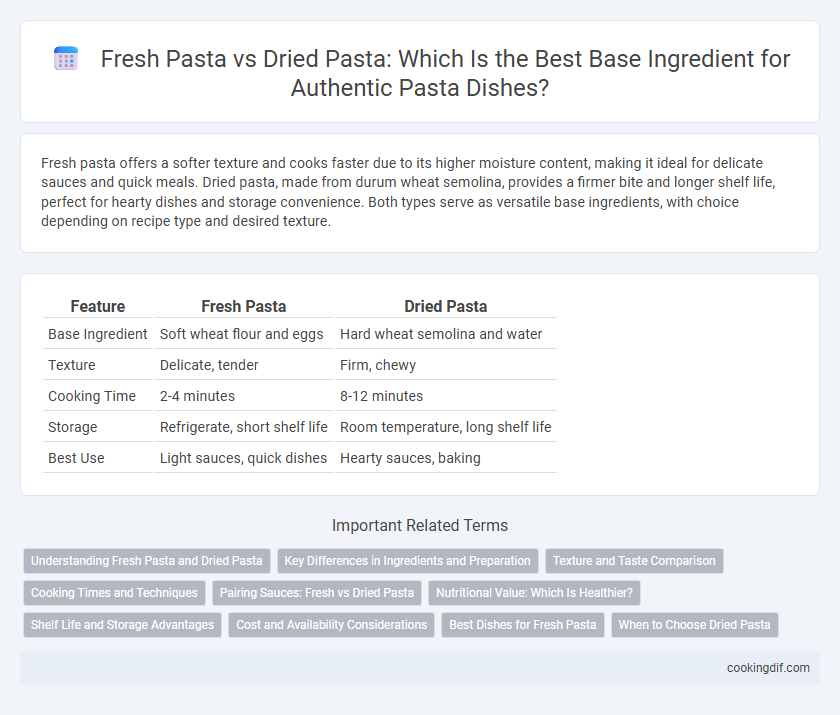Fresh pasta offers a softer texture and cooks faster due to its higher moisture content, making it ideal for delicate sauces and quick meals. Dried pasta, made from durum wheat semolina, provides a firmer bite and longer shelf life, perfect for hearty dishes and storage convenience. Both types serve as versatile base ingredients, with choice depending on recipe type and desired texture.
Table of Comparison
| Feature | Fresh Pasta | Dried Pasta |
|---|---|---|
| Base Ingredient | Soft wheat flour and eggs | Hard wheat semolina and water |
| Texture | Delicate, tender | Firm, chewy |
| Cooking Time | 2-4 minutes | 8-12 minutes |
| Storage | Refrigerate, short shelf life | Room temperature, long shelf life |
| Best Use | Light sauces, quick dishes | Hearty sauces, baking |
Understanding Fresh Pasta and Dried Pasta
Fresh pasta typically contains higher moisture content, providing a tender texture that cooks quickly, making it ideal for delicate sauces and dishes requiring minimal cooking time. Dried pasta, produced through long drying processes, offers extended shelf life and a firmer texture, which pairs well with robust sauces and hearty recipes. Choosing between fresh and dried pasta depends on the desired cooking method, sauce compatibility, and storage needs.
Key Differences in Ingredients and Preparation
Fresh pasta contains higher moisture content, made primarily from flour and eggs, resulting in a tender texture and shorter cooking time. Dried pasta is made from durum wheat semolina and water, providing a firmer texture and longer shelf life due to dehydration. Preparation differs as fresh pasta requires gentle cooking to preserve softness, while dried pasta demands boiling until al dente to achieve optimal bite.
Texture and Taste Comparison
Fresh pasta offers a tender, silky texture with a rich, buttery taste due to its higher moisture content and use of eggs, making it ideal for delicate sauces. Dried pasta has a firmer, chewier bite and a nuttier flavor from its longer drying process, enhancing its ability to hold up in hearty, robust dishes. The choice between fresh and dried pasta significantly impacts the mouthfeel and flavor profile, tailoring the culinary experience to specific recipes.
Cooking Times and Techniques
Fresh pasta cooks rapidly, typically requiring only 2 to 4 minutes due to its higher moisture content and delicate texture, making it ideal for quick sautes and light sauces. Dried pasta, denser and low in moisture, demands longer cooking times ranging from 8 to 12 minutes and benefits from boiling in ample salted water to achieve al dente firmness. Techniques for fresh pasta emphasize gentle handling and minimal cooking to preserve tenderness, while dried pasta calls for vigorous boiling and occasional stirring to prevent sticking and ensure even cooking.
Pairing Sauces: Fresh vs Dried Pasta
Fresh pasta pairs best with light, delicate sauces such as olive oil, butter, or simple cream-based sauces, as its tender texture absorbs flavors gently. Dried pasta holds up well to robust, hearty sauces like marinara, Bolognese, or chunky vegetable ragu due to its firm structure and longer cooking time. Choosing the right pasta type enhances the overall dish by balancing sauce intensity and texture.
Nutritional Value: Which Is Healthier?
Fresh pasta typically contains higher moisture content and fewer preservatives, resulting in a slightly lower calorie count and more protein per serving compared to dried pasta. Dried pasta, being more concentrated due to the removal of water, often provides higher carbohydrate density and longer shelf life, preserving fiber content effectively. Nutritionally, fresh pasta may offer more vitamins like B-complex, but dried pasta remains a healthier option for higher fiber intake and sustained energy release.
Shelf Life and Storage Advantages
Fresh pasta contains higher moisture content, giving it a shelf life of just a few days when refrigerated, whereas dried pasta, dehydrated to less than 12% moisture, can be stored for up to two years in a cool, dry pantry. The water activity in fresh pasta makes it more susceptible to microbial growth and spoilage, requiring airtight packaging and refrigeration or freezing for extended storage. Dried pasta offers superior storage advantages due to its low moisture content, long shelf life, and resistance to spoilage without refrigeration, making it ideal for bulk storage and long-term use.
Cost and Availability Considerations
Fresh pasta typically costs more due to shorter shelf life and requires refrigeration, impacting availability and frequent purchasing needs. Dried pasta offers lower cost per serving, extended shelf stability, and widespread availability in most grocery stores, making it a convenient pantry staple. Choosing between fresh and dried pasta depends on budget constraints and access to refrigerated products.
Best Dishes for Fresh Pasta
Fresh pasta, made from higher moisture dough, provides a tender texture ideal for delicate sauces like Alfredo or light olive oil-based dressings. It excels in dishes such as fettuccine alfredo, ravioli stuffed with ricotta and spinach, and tagliatelle with fresh tomato and basil. The softness and pliability of fresh pasta allow it to absorb flavors better, making it perfect for recipes requiring subtle sauce integration.
When to Choose Dried Pasta
Dried pasta is ideal for long-term storage and recipes requiring firm texture, such as baked dishes and hearty sauces. Its lower moisture content allows it to hold shape during prolonged cooking and absorb robust flavors effectively. Choosing dried pasta ensures convenience and versatility, especially in busy kitchens or when preparing large meals.
Fresh pasta vs dried pasta for base ingredient Infographic

 cookingdif.com
cookingdif.com